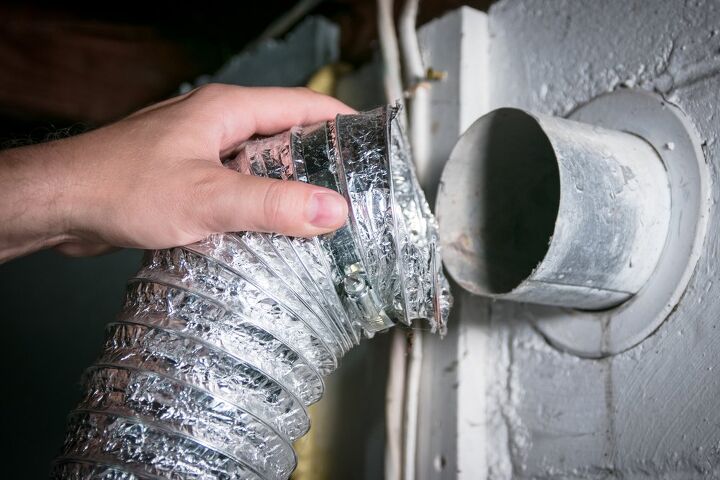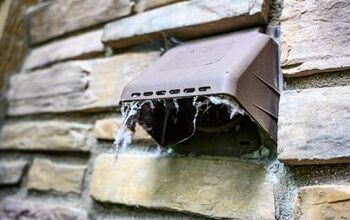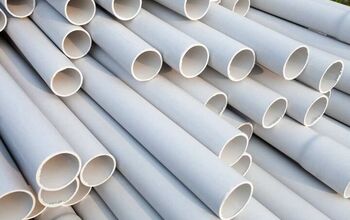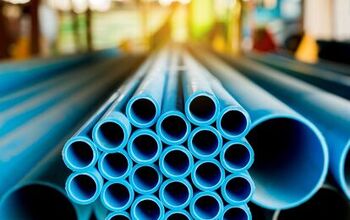Can You Use PVC Pipe For Dryer Vent? (Find Out Now!)

PVC pipe is relatively cheap, easy to use, and comes in a wide variety of sizes. In some cases, PVC pipe is routinely used for vents on waste systems in a home. Many homeowners faced with replacing or repairing a dryer vent see PVC pipe as a solution. However, PVC pipe is not a viable option for dryer vents.
PVC pipe is not suitable for dryer vents due to its relatively low operating temperature maximum. Residential clothes dryers can produce air temperatures in the vent system that can compromise the structural integrity of the PVC pipe. The pipe may soften, melt, or in extreme cases, burn. These temperatures can cause the PVC pipe to emit harmful vapors as well.
There are many uses in your home where PVC pipe excels. However, PVC pipe falls short of the mark as a clothes dryer vent pipe. There are many more suitable options for venting your clothes dryer than PVC pipe. Understanding the dangers and problems with PVC pipe as a dryer vent can help you understand why this is not a recommended practice.
Do You Need Ducts or Vents Installation or Replacement?
Get free, zero-commitment quotes from pro contractors near you.

What is PVC Pipe?
PVC pipe is made from a plastic material and stands for polyvinyl chloride. PVC is a synthetic plastic polymer that can be formed into various shapes. When used for pipe, PVC is typically a rigid white material that resists corrosion. Some experts report that PVC is the third most widely produced plastic globally.
Rigid, or uPVC, is considered food safe and used in potable water systems. Greater care must be used when other types of PVC are used. Some non-rigid PVC pipe or tubing includes additives that are not considered food safe. You should always check the manufacturer’s specifications before using a PVC product in a potable water system.
The Problems with Temperature and PVC Pipe
One of the problems with using PVC pipe to vent a clothes dryer is temperature. Most schedule 40 PVC pipes will soften and lose their structural integrity at 200 degrees Fahrenheit. This temperature is well above the industry standard temperature for residential clothes dryers. In most cases, residential clothes dryers operate between 125 and 135 degrees Fahrenheit.
It would appear that this is a great enough safety margin to make schedule 40 PVC pipe suitable for use as a dryer vent. However, long-term exposure to these temperatures can cause the PVC pipes to become brittle. Vibration from the dryer can further weaken the pipe making a crack or break more likely.
Don’t Overlook Static Electricity Problems
As warm moist air passes through or over PVC pipe, it creates high static electricity levels. These levels of static electricity charge can cause several problems. The most aggravating problem with static electricity are the shocks you can receive from simply touching your dryer.
For the most part, these electrical shocks from static electricity are not dangerous, but they can be annoying and painful. Using PVC pipe for your dryer vent can compound the static electricity problem with your dryer.
An unforeseen danger with static electricity discharges involves the lint build-up that often occurs in vent pipes and lint filters in your dryer. If a lint build-up occurs in the PVC pipe, it can become a source of fire. A static electric spark near this lint is often enough to ignite the lint inside the vent.
Stay Within The Building Codes
Most building codes in the US prohibit using PVC pipes for dryer vents. There are several reasons for these prohibitions. You may save yourself time and money by avoiding PVC pipes when rebuilding your dryer vents.
If you decide to sell your home and a home inspection is required, more than likely, the inspector will document the PVC vent pipe and require it to be replaced. If you have work done in your home that requires a permit and inspection, the building inspector may also notice the out-of-code condition of your dryer vent.
What is the Best Alternative for A Dryer Vent?
In general, the best alternative for venting your dryer is metal. The metal dryer vent can be steel or aluminum, and both are good alternatives. There are several reasons that metal is the proper choice for venting your dryer.
- Metal dryer vent will not degrade from the prolonged exposure to the heat and moisture from the dryer.
- Metal dryer vent material is smooth and provides clean and efficient air movement through the duct.
- Static electricity is not as big a problem as you encounter with PVC pipe.
- Lint is less likely to build up in a metal vent, which helps prevent clogs and restrictions in your dryer vent.
Overall, most residential clothes dryer manufacturers recommend using metal dryer vents rather than PVC. In some cases, using PVC pipe for a dryer vent may void the warranty on a new residential clothes dryer.
What Other Considerations Should I Take For My Dryer Vent?
If you are installing a new dryer vent, you will need to make an opening of the correct size through an exterior wall. If your home has a brick veneer siding, this can be a challenge, and you may need to hire a professional to create this opening. Other considerations when venting a dryer include:
- Never vent a clothes dryer into the attic. This can add moisture to the attic space. A warm moist space filled with insulation is a recipe for mold and mildew growth which can invade your home.
- Any dryer vent should be at least four inches in diameter.
- Avoid making a lot of turns in your dryer vent. Turns in the vent can restrict airflow, which means your clothes dryer has to work harder and less efficiently.
- Always follow the manufacturer’s recommendations when venting your residential clothes dryer. This is especially important to protect the warranty on new clothes dryers.
Most clothes dryers require a flexible duct length to connect the dryer to the vent pipe. Make sure you select a flexible duct that is meant for use with residential clothes dryers.
Do You Need Ducts or Vents Installation or Replacement?
Get free, zero-commitment quotes from pro contractors near you.

PVC Pipe – Not For Dryer Vents
There are much better alternatives for venting your dryer than PVC pipe. Choosing the right vent pipe can enable your clothes dryer to operate more efficiently and have a longer working life. The cost difference is negligible between metal and PVC vent pipes. So do yourself and your dryer a favor by installing the best choice in vent pipe.

Dennis is a retired firefighter with an extensive background in construction, home improvement, and remodeling. He worked in the trades part-time while serving as an active firefighter. On his retirement, he started a remodeling and home repair business, which he ran for several years.
More by Dennis Howard


























![10 Most Dangerous Neighborhoods in Baltimore [Updated]](https://cdn-fastly.upgradedhome.com/media/2023/07/31/9075655/10-most-dangerous-neighborhoods-in-baltimore-updated.jpg?size=350x220)
